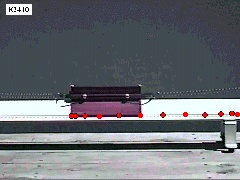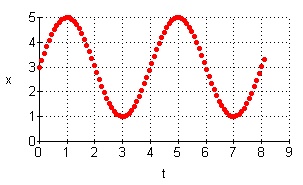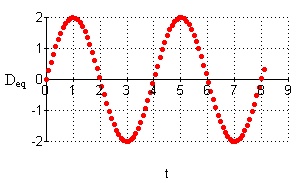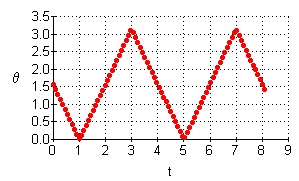
 |
Figure 1. Springs attached to an air glider cause it to oscillate horizontally. |
When a mass, m, is attached to a spring and displaced from its equilibrium position, then it will oscillate. In other words, the motion of the mass will repeat itself after a specific time. We call this simple harmonic motion with period T. Since the acceleration is not constant, we cannot use the equations for constant acceleration. However, since the motion repeats itself, we might try a sinusoidal function.
Equations for simple harmonic motion
If the mass oscillates in the x direction, then the equation for x is:
x = xeq + Acos(qo + wt)
Here:
The displacement from equilibrium is Deq = x - xeq or:
Deq = Acos(qo + wt)
The velocity of the mass is:
v = -wAsin(qo + wt)
And the acceleration of the mass is:
a = -w2Acos(qo + wt)
Other relationships are:
w = 2p/T
k = mw2
Where T is the period of motion, k is the spring constant, and m is the mass.
If the equation for Deq above is true then the following equation is also valid.
cos-1(Deq/A) = q = qo + wt
This says that q is a linear function of time with slope w and intercept qo.
The kinetic and potential energies for a mass/spring system are:
KE = 0.5mv2
PE = 0.5kDeq2
If the mechanical energy is conserved then:
DKE = -DPE
An Example

Figure 2 shows a position versus time graph. The maximum value is 5 and the minimum value is 1. Therefore, the equilibrium position is 3 and the amplitude is, A = 2 m. The plot repeats itself every four seconds, therefore the period is, T = 4 s and w = 2p/T = 1.57 rad/s. Placing these values into the position equation at t = 1 s, we have:
x = xeq + Acos(qo + wt)
5 = 3 + 2cos(qo + 1.57(1))
Solving for qo gives:
qo = -1.57 radians
We now have all the values we need to write all the equations given at the beginning of this section.

Figure 3 shows a displacement versus time graph. The amplitude is, A = 2 m. The plot repeats itself every four seconds, therefore the period is, T = 4 s and w = 2p/T = 1.57 rad/s. Placing these values into the displacement equation at t = 3 s, we have:
Deq = Acos(qo + wt)
-2 = 2cos(qo + 1.57(3))
Solving for qo gives:
qo = -1.57 radians
We now have all the values we need to write all the equations given at the beginning of this section except for the equilibrium position.

Figure 4 was generated using the following equation:
cos-1(Deq/A) = q = qo + wt
Figure 4 is piecewise linear, and we can find qo and w by finding the intercept and slope of any of the linear segments. Using the first segment, the intercept is about 1.5 and the slope is about -1.5. Therefore we can write:
qo = 1.5 rad and w = -1.5 rad/s
These values are close to those calculated from Figures 2 and 3, however, they are the negatives of those values. This is a characteristic of the cosine function because:
cos(A) = cos (-A) for all A.
Try using other linear segments from Figure 4 to find qo and w. Use these values to calculate positions and displacements at various times and check these values using Figures 2 and 3.
Note: To review sinusoidal graphs, run the Graph Tutor software that came on this CD.